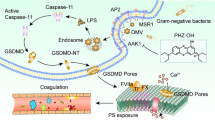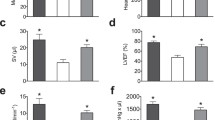Abstract
Background
Septic shock is a leading cause of mortality in intensive care units. No new interventions in the last 20 years have made a substantial impact on the outcome of patients with septic shock. Identification of inhibitable pathways that mediate death in shock is an important goal.
Materials and Methods
Two novel caspase inhibitors, (2-indolyl)-carbonyl-Ala-Asp-fluoromethylketone (IDN 1529) and (1-methyl-3-methyl-2-indolyl)-carbonyl-Val-Asp-fluoromethylketone (IDN 1965), were studied in a murine model of endotoxic shock.
Results
IDN 1529 prolonged survival when given before or up to 3 hr after high-dose LPS (p < 0.01) and increased by 2.2-fold the number of animals surviving longterm after a lower dose of LPS (p < 0.01). Despite its similar chemical structure, IDN 1965 lacked these protective effects. Both compounds inhibited caspases 1, 2, 3, 6, 8, and 9, and both afforded comparable reduction in Fas- and LPS-induced caspase 3-like activity and apoptosis. Paradoxically, administration of IDN 1529 but not IDN 1965 led to an increase in the LPS-induced elevation of serum cytokines related directly (IL-1β, IL-18) or indirectly (IL-1α, IL-1Ra) to the action of caspase 1.
Conclusions
A process that appears to be distinct from both apoptosis and the release of inflammatory cytokines is a late-acting requirement for lethality in endotoxic shock. Inhibition of this process can rescue mice even when therapy is initiated after LPS has made the mice severely ill.






Similar content being viewed by others
References
Astiz ME, Rackow AC. (1998) Septic shock. Lancet 351: 1501–1505.
Salvesen GS, Dixit VM. (1997) Caspases: Intracellular signaling by proteolysis. Cell 91: 443–446.
Thornberry NA, Lazebnik Y. (1998) Caspases: Enemies within. Science 281: 1312–1316.
Li P, Allen H, Banerjee S, et al. (1995) Mice deficient in IL-1 beta-converting enzyme are defective in production of mature IL-1 beta and resistant to endotoxic shock. Cell 80: 401–411.
Kuida K, Lippke JA, Ku G, et al. (1995) Altered cytokine export and apoptosis in mice deficient in interleukin-1 beta converting enzyme. Science 267: 2000–2003.
Wang S, Miura M, Jung YK, Zhu H, Li E, Yuan J. (1998) Murine caspase-11, an ICE-interacting protease, is essential for the activation of ICE. Cell 92: 501–509.
Gu Y, Kuida K, Tsutsui H, et al. (1997) Activation of interferon-gamma inducing factor mediated by interleukin-1 beta converting enzyme. Science 275: 206–209.
Ghayur T, Banerjee S, Hugunin M, et al. (1997) Caspase-1 processes IFN-gamma-inducing factor and regulates LPS-induced IFN-gamma production. Nature 386: 619–623.
Bohlinger I, Leist M, Gantner F, Angermuller S, Tiegs G, Wendel A. (1996) DNA fragmentation in mouse organs during endotoxic shock. Am. J. Pathol. 149: 1381–1393.
Haendeler J, Messmer UK, Brune B, Neugebauer E, Dimmeier S. (1996) Endotoxic shock leads to apoptosis in vivo and reduces Bcl-2. Shock 6: 405–409.
Hiramatsu M, Hotchkiss RS, Karl IE, Buchman TG. (1997) Cecal ligation and puncture (CLP) induces apoptosis in thymus, spleen, lung, and gut 593 by an endotoxin and TNF-independent pathway. Shock 7: 247–253.
Haimovitz-Friedman A, Cordon-Cardo C, Bayoumy S, et al. (1997) Lipopolysaccharide induces disseminated endothelial apoptosis requiring ceramide generation. J. Exp. Med. 186: 1831–1841.
Ogasawara J, Watanabe-Fukunaga R, Adachi M, et al. (1992) Lethal effect of anti-Fas antibody in mice. Nature 365: 806–809.
Jaeschke H, Fisher MA, Lawson JA, Simmons CA, Farhood A, Jones DA. (1998) Activation of caspase 3 (CPP32)-like proteases is essential for TNF-alpha-induced hepatic parenchymal cell apoptosis and neutrophil-mediated necrosis in a murine endotoxin shock model. J. Immunol. 160: 3480–3486.
Armstrong RC, Aja T, Xiang J, et al. (1996) Fasinduced activation of the cell death-related protease CPP32 is inhibited by Bcl-2 and by ICE family protease inhibitors. J. Biol. Chem. 271: 16850–16855.
Mittl PR, Di Marco S, Krebs JF, et al. (1997) Structure of recombinant human CPP32 in complex with the tetrapeptide acetyl-Asp-Val-Ala-Asp fluoromethylketone. J. Biol. Chem. 272: 6539–6547.
Perregaux D, Barberia J, Lanzetti AJ, Geoghegan KF, Carty TJ, Gabel CA. (1992) IL-1 beta maturation: Evidence that mature cytokine formation can be induced specifically by nigericin. J. Immunol. 149: 1294–1303.
Hogquist KA, Nett MA, Unanue ER, Chaplin DD. (1991) Interleukin 1 is processed and released during apoptosis. Proc. Natl. Acad. Sci. U.S.A. 88: 8485–8489.
Gabay C, Porter B, Fantuzzi G, Arend WP. (1997) Mouse IL-1 receptor antagonist isoforms: Complementary DNA cloning and protein expression of intracellular isoform and tissue distribution of secreted and intracellular IL-1 receptor antagonist in vivo. J. Immunol. 159: 5905–5913.
de Olivera RM, Sipe JD, de Beer FC, et al. (1994) Rapid, sensitive enzyme-linked immunosorbent assays (ELISA) for serum amyloid A (apoSAA) in human plasma and tissue culture fluids. Int. J. Exp. Clin. Invest. 1: 23–29.
Wu JC, Fritz LC. (1999) A Companion to Methods in Enzymology. (in press).
MacMicking JD, Nathan C, Horn G, et al. (1995) Altered responses to bacterial infection and endotoxic shock in mice lacking inducible nitric oxide synthase. Cell 81: 641–650.
Krege JH, Hodgin JB, Hagaman JR, Smithies O. (1995) A noninvasive computerized tail-cuff system for measuring blood pressure in mice. Hypertension 25: 1111–1115.
Dinarello CA. (1997) Interleukin-1. Cytogenet. Gr. Fac. Rev. 8: 253–265.
Matshushima K, Taguchi M, Kovacs EJ, Young HA, Oppenheim JJ. (1986) Intracellular localization of human monocyte associated interleukin 1 (IL-1) activity and release of biologically active IL-1 from monocytes by trypsin and plasmin. J. Immunol. 136: 2883–2891.
Black RA, Kronheim SR, Cantrell M, et al. (1988) Generation of biologically active interleukin-1 beta by proteolytic cleavage of the inactive precursor. J. Biol. Chem. 263: 9437–9442.
Hazuda DJ, Strickler J, Kueppers F, Simon PL, Young PR. (1990) Processing of precursor interleukin 1 beta and inflammatory disease. J. Biol. Chem. 265: 6318–6322.
Gabay C, Smith MF, Eidlen D, Arend WP. (1997) Interleukin 1 receptor antagonist (IL-1Ra) is an acute-phase protein. J. Clin. Invest. 99: 2930–2940.
Hirsch E, Irikura VM, Paul SM, Hirsh D. (1996) Functions of interleukin 1 receptor antagonist in gene knockout and overproducing mice. Proc. Natl. Acad. Sci. U.S.A. 93: 11008–11013.
Dinarello CA, Novick D, Puren AJ, et al. (1998) Overview of interleukin-18: More than an interferon-gamma inducing factor. J. Leukoc. Biol. 63: 658–664.
Puren AJ, Fantuzzi G, Dinarello CA. (1999) Gene expression, synthesis, and secretion of interleukin 18 and interleukin 1B are differentially regulated in human blood mononuclear cells and mouse spleen cells. Proc. Natl. Acad. Sci. U.S.A. 96: 2256–2261.
Doherty GM, Lange JR, Langstein HN, Alexander HR, Buresh CM, Norton JA. (1992) Evidence for IFN-gamma as a mediator of the lethality of endotoxin and tumor necrosis factor-alpha. J. Immunol. 149: 1666–1670.
Beutler B, Milsark W, Cerami A. (1985) Passive immunization against cachectin/tumor necrosis factor protects mice from lethal effect of endotoxin. Science 229: 869–871.
McCabe WR, Greely A. (1972) Immunization with R mutants of S. minnesota I. Protection against challenge with heterologous gram-negative bacilli. J. Immunol. 108: 601–610.
Schimke J, Mathison J, Morgiewicz J, Ulevitch RJ. (1998) Anti-CD14 mAb treatment provides therapeutic benefit after in vivo exposure to endotoxin. Proc. Natl. Acad. Sci. U.S.A. 95: 13875–13880.
Casals-Stenzel J. (1987) Protective effect of WEB 2086, a novel antagonist of platelet activating factor, in endotoxic shock. J. Pharmacol. 135: 117–122.
Silver GM, Gameiii RL, O’Reilly M, Hebert JC. (1990) The effect of interleukin 1 alpha on survival in a murine model of burn wound sepsis. Arch. Surg. 125: 922–925.
Guirao X, Lowry SF. (1996) Biologic control of injury and inflammation: Much more than too little or too late. World J. Surg. 20: 437–446.
Howard M, Muchamuel T, Andrade S, Menon S. (1993) Interleukin 10 protects mice from lethal endotoxemia. J. Exp. Med. 177: 1205–1208.
Fletcher DS, Agarwal L, Chapman KT, et al. (1995) A synthetic inhibitor of interleukin-1 beta converting enzyme prevents endotoxin-induced interleukin-1 beta production in vitro and in vivo. J. Interfon Cytokine Res. 15: 243–248.
Miller BE, Krasney PA, Gauvin DM, et al. (1995) Inhibition of mature IL-1 beta production in murine macrophages and a murine model of inflammation by WIN 67694, an inhibitor of IL-1 beta converting enzyme. J. Immunol. 154: 1331–1338.
Mignon A, Rouquet N, Fabre M, et al. (1999) LPS challenge in D-galactosamine-sensitized mice accounts for caspase-dependent fulminant hepatitis, not for septic shock. Am. J. Respir. Crit. Care Med. 159: 1308–1315.
Perregaux DG, Gabel CA. (1998) Post-translational processing of murine IL-1: Evidence that ATP-induced release of IL-1 alpha and IL-1 beta occurs via a similar mechanism. J. Immunol. 160: 2469–2477.
Irmler M, Hertig S, MacDonald HR, et al. (1995) Granzyme A is an interleukin 1 beta-converting enzyme. J. Exp. Med. 181: 1917–1922.
Schonbeck U, Mach F, Libby P. (1998) Generation of biologically active IL-1 beta by matrix metallo-proteinases: A novel caspase-1-independent pathway of IL-1 beta processing. J. Immunol. 161: 3340–3346.
Schotte P, Declercq W, Huffel SV, Vanderabeele P, Beyaert R. (1999) Non-specific effects of methyl ketone peptide inhibitors of caspases. FEBS Lett. 224: 117–121.
Acknowledgments
We thank Karen Valentino, Anu Srinivasan, and Michael Shiloh for their assistance. This work was supported in part by NIH grant GM53921 to C.F.N.; a Trauma and Injury Biology Research Fellowship to S.R.G. via NIH training grant GM08466; NIH grant AR40135 to W.P.A.; and post-doctoral fellowships from Swiss National Science Foundation and la Foundation Suisse de Bourse de Medecine et Biologie to C.G.
Author information
Authors and Affiliations
Corresponding author
Additional information
Communicated by C. Nathan.
Rights and permissions
About this article
Cite this article
Grobmyer, S.R., Armstrong, R.C., Nicholson, S.C. et al. Peptidomimetic Fluoromethylketone Rescues Mice from Lethal Endotoxic Shock. Mol Med 5, 585–594 (1999). https://doi.org/10.1007/BF03402071
Accepted:
Published:
Issue Date:
DOI: https://doi.org/10.1007/BF03402071




